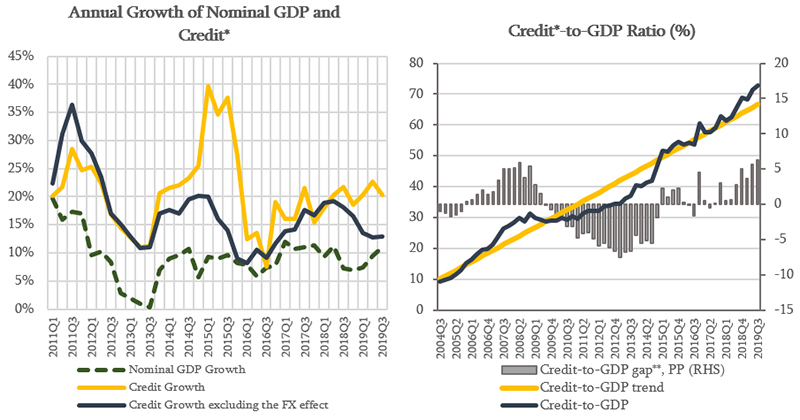
Financial Stability Committee's Decision
Financial Stability Committee of the
National Bank of Georgia made a decision to leave the countercyclical buffer
unchanged, at 0%. Since the regulation of responsible lending to natural
persons came into force in January 2019, the growth of loans has been following
the expected tendency. The annual growth rate of credit portfolio in October
2019 amounted to 13.9%, excluding the exchange rate effect, which is mainly due
to the growth of loans to legal entities. It should be noted that Credit-to-GDP
ratio still exceeds its long run trend, mainly due to exchange rate effect and
the excessive credit growth in past periods. According to the Committee's
assessment, the lending growth will converge to its sustainable level in the
medium term.
Source: NBG; Geostat
* Credit includes loans
directly issued by commercial banks and microfinance institutions as well as
bonds issued domestically by the non-financial sector.
** Credit-to-GDP gap is
the deviation of Credit-to-GDP ratio from its long-run trend. The trend is
estimated using HP filter in line with the Basel recommendations
Georgian financial system remains resilience against potential shocks. The banking sector is highly capitalized and liquid, and maintains high profitability indicators, while share of non-performing loans in total credit remains low. However, it should be noted that usually in the ascending credit cycle the share of non-performing loans decreases. Therefore, this indicator should not be interpreted too optimistically.
The National Bank of Georgia continues to monitor the country's financial stability and assess domestic and foreign risks. If necessary, it will use all available instruments to minimize the possible risks.
The Financial Stability Committee's next meeting will be held on February 26, 2020.
